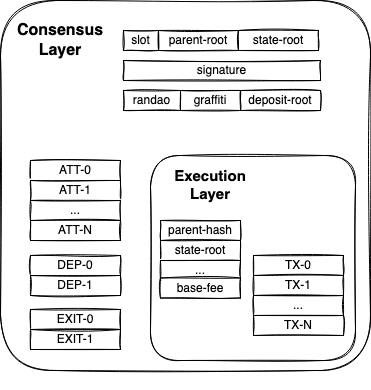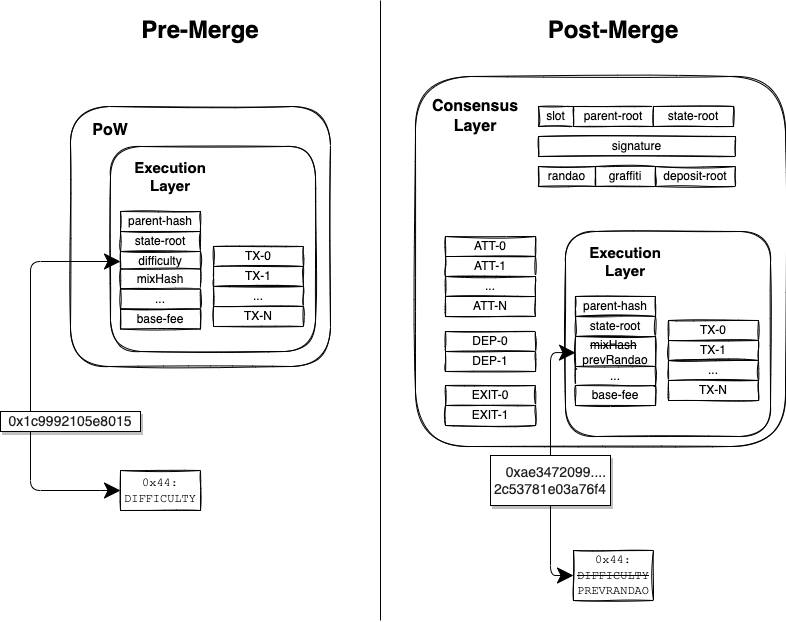Ethereum’s transition to proof of stake — The Merge — is close to: devnets are being stood up, specs are being finalized and group outreach has begun in earnest. The Merge is designed to have minimal affect on how Ethereum operates for finish customers, good contracts and dapps. That stated, there are some minor modifications price highlighting. Earlier than we dive into them, listed here are a couple of hyperlinks to offer context concerning the general Merge structure:
The remainder of this publish will assume the reader is accustomed to the above. For these eager to dig even deeper, the total specs for The Merge can be found right here:
Block construction
After The Merge, proof of labor blocks will now not exist on the community. As an alternative, the previous contents of proof of labor blocks turn out to be a part of blocks created on the Beacon Chain. You possibly can then consider the Beacon Chain as changing into the brand new proof of stake consensus layer of Ethereum, superseding the earlier proof of labor consensus layer. Beacon chain blocks will include ExecutionPayloads, that are the post-merge equal of blocks on the present proof of labor chain. The picture beneath exhibits this relationship:

For finish customers and utility builders, these ExecutionPayloads are the place interactions with Ethereum occur. Transactions on this layer will nonetheless be processed by execution layer shoppers (Besu, Erigon, Geth, Nethermind, and so forth.). Fortuitously, because of the stability of the execution layer, The Merge introduces solely minimal breaking modifications.
Mining & Ommer Block Fields
Submit-merge, a number of fields beforehand contained in proof of labor block headers turn out to be unused as they’re irrelevant to proof of stake. With a purpose to decrease disruption to tooling and infrastructure, these fields are set to 0, or their information construction’s equal, slightly than being totally faraway from the information construction. The complete modifications to dam fields may be present in EIP-3675.
| Area | Fixed worth | Remark |
|---|---|---|
| ommers | [] | RLP([]) = 0xc0 |
| ommersHash | 0x1dcc4de8dec75d7aab85b567b6ccd41ad312451b948a7413f0a142fd40d49347 | = Keccak256(RLP([])) |
| problem | 0 | |
| nonce | 0x0000000000000000 |
As a result of proof of stake doesn’t naturally produce ommers (a.ok.a. uncle blocks) like proof of labor, the record of those in every block (ommers) might be empty, and the hash of this record (ommersHash) will turn out to be the RLP-encoded hash of an empty record. Equally, as a result of problem and nonce are options of proof of labor, these might be set to 0, whereas respecting their byte-size values.
mixHash, one other mining-related discipline, will not be set to 0 however will as a substitute include the beacon chain’s RANDAO worth. Extra on this beneath.
BLOCKHASH & DIFFICULTY opcodes modifications
Submit-merge, the BLOCKHASH opcode will nonetheless be obtainable to be used, however given that it’s going to now not be cast via the proof of labor hashing course of, the pseudorandomness offered by this opcode might be a lot weaker.
Relatedly, the DIFFICULTY opcode (0x44) might be up to date and renamed to PREVRANDAO. Submit-merge, it’ll return the output of the randomness beacon offered by the beacon chain. This opcode will thus be a stronger, albeit nonetheless biasable, supply of randomness for utility builders to make use of than BLOCKHASH.
The worth uncovered by PREVRANDAO might be saved within the ExecutionPayload the place mixHash, a worth related to proof of labor computation, was saved. The payload’s mixHash discipline will even be renamed prevRandao.
Right here is an illustration of how the DIFFICULTY & PREVRANDAO opcodes work pre and post-merge:

Pre-merge, we see the 0x44 opcode returns the problem discipline within the block header. Submit-merge, the opcode, renamed to PREVRANDAO, factors to the header discipline which beforehand contained mixHash and now shops the prevRandao worth from the beacon chain state.
This alteration, formalized in EIP-4399, additionally supplies on-chain purposes a solution to assess whether or not The Merge has occurred. From the EIP:
Moreover, modifications proposed by this EIP enable for good contracts to find out whether or not the improve to the PoS has already occurred. This may be accomplished by analyzing the return worth of the DIFFICULTY opcode. A worth larger than 2**64 signifies that the transaction is being executed within the PoS block.
Block time
The Merge will affect the typical block time on Ethereum. At the moment underneath proof of labor, blocks are available in on common each ~13 seconds with a good quantity of variance in precise block occasions. Underneath proof of stake, blocks are available in precisely every 12 seconds besides when a slot is missed both as a result of a validator is offline or as a result of they don’t submit a block in time. In apply, this at the moment occurs in <1% of slots.
This suggests a ~1 second discount of common block occasions on the community. Good contracts which assume a specific common block time of their calculations might want to take this into consideration.
Finalized Blocks & Protected Head
Underneath proof of labor there’s all the time the potential for reorgs. Functions normally look forward to a number of blocks to be mined on prime of a brand new head earlier than treating it as unlikely to be faraway from the canonical chain, or “confirmed”. After The Merge, we as a substitute have the ideas of finalized blocks and secure head uncovered on the execution layer. These blocks can be utilized extra reliably than the “confirmed” proof of labor blocks however require a shift in understanding to make use of appropriately.
A finalized block is one which has been accepted as canonical by >2/3 of validators. To create a conflicting block, an attacker must burn no less than 1/3 of the overall staked ether. Whereas stake quantities could differ, such an assault is all the time anticipated to value the attacker thousands and thousands of ETH.
A secure head block is one which has been justified by the Beacon Chain, that means that >2/3 of validators have attested to it. Underneath regular community situations, we anticipate it to be included within the canonical chain and finally finalized. For this block to not be a part of the canonical chain, a majority of validators would should be colluding to assault the community, or the community must be experiencing excessive ranges of latency in block propagation. Submit-merge, execution layer APIs (e.g. JSON RPC) will expose the secure head utilizing a secure tag.
Finalized blocks will even be uncovered by way of JSON RPC, by way of a brand new finalized flag. These can then function a stronger substitute for proof of labor confirmations. The desk beneath summarizes this:
| Block Sort | Consensus Mechanism | JSON RPC | Situations for reorg |
|---|---|---|---|
| head | Proof of Work | newest | To be anticipated, have to be used with care. |
| secure head | Proof of Stake | secure | Doable, requires both giant community delay or assault on community. |
| confirmed | Proof of Work | N/A | Unlikely, requires a majority of hashrate to mine a competing chain of depth > # of confirmations. |
| finalized | Proof of Stake | finalized | Extraordinarily unlikely, requires >2/3 of validators to finalize a competing chain, requiring no less than 1/3 to be slashed. |
Observe: the JSON RPC specification remains to be underneath energetic improvement. Naming modifications ought to nonetheless be anticipated.
Subsequent Steps
We hope this publish helps utility builders put together for the much-anticipated transition to proof of stake. Within the subsequent few weeks, a long-lived testnet might be made obtainable for testing by the broader group. There may be additionally an upcoming Merge community call for infrastructure, tooling and utility builders to ask questions and listen to the most recent technical updates about The Merge. See you there 👋🏻
Thanks to Mikhail Kalinin, Danny Ryan & Matt Garnett for reviewing drafts of this publish.







